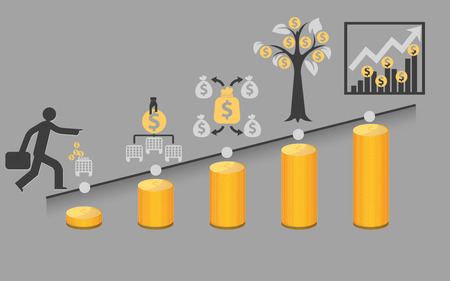1. Automate Your Savings
If you’re like most Americans, it’s easy to forget to set aside money for your short-term goals—like a weekend getaway or a new phone. That’s where automation comes in! Setting up automatic transfers to a high-yield savings account helps you save money without even thinking about it. Here’s how it works:
Why Automate?
When you automate your savings, a set amount of money moves from your checking account to your savings account every week or month. This “set it and forget it” approach takes the guesswork out of saving and helps you reach your financial goals faster.
How to Set Up Automatic Transfers
| Step | What To Do |
|---|---|
| 1 | Pick a high-yield savings account with no monthly fees and a strong interest rate. |
| 2 | Decide how much you want to save each pay period (even $10 or $25 adds up!). |
| 3 | Log in to your online banking and schedule recurring transfers from checking to savings on payday. |
| 4 | Watch your balance grow automatically—no extra effort needed! |
Pro Tip:
If you get a raise or bonus, increase your transfer amount right away. You won’t miss the extra cash, but your savings will jump up fast!
2. Take Advantage of Cash Back and Rewards Programs
When it comes to short-term savings, one of the easiest ways Americans can stretch their dollars is by making the most out of cash back and rewards programs. These savings hacks are built right into everyday purchases, helping you save money on things you’re already buying. Let’s explore how to maximize these benefits with credit cards, loyalty programs, and rebate apps.
Popular Credit Card Cash Back Offers
Many American credit cards offer cash back on common categories like groceries, gas, dining out, and even online shopping. Choosing the right card for your lifestyle means you’ll be getting a little bit back every time you swipe or tap.
| Credit Card | Cash Back Categories | Typical Rewards Rate |
|---|---|---|
| Chase Freedom Unlimited® | All Purchases | 1.5% – 5% |
| Discover it® Cash Back | Rotating Quarterly Categories (e.g., grocery stores, gas stations) | 5% (on select categories), 1% (others) |
| Blue Cash Everyday® Card from American Express | Supermarkets, Gas Stations, Online Retailers | Up to 3% |
Loyalty Programs: Everyday Stores & Brands
Loyalty programs at stores you frequent—like Target Circle, Walgreens Balance Rewards, or Starbucks Rewards—can quickly add up to free products, discounts, or even cashback on your purchases. All you need to do is sign up (usually free) and scan your member code at checkout.
- Grocery stores: Sign up for rewards cards or apps for exclusive savings.
- Coffee shops: Collect points for every purchase to redeem for free drinks or snacks.
- Pharmacies: Earn points for prescriptions and regular buys, turning them into store credit.
Rebate Apps: Get Money Back Instantly
Apps like Ibotta, Rakuten, and Fetch Rewards let you earn cash back by scanning receipts or shopping through their portals. They cover everything from groceries to clothing to travel bookings. It’s as simple as uploading your receipt or clicking through their links before shopping online.
| App Name | Main Features | Payout Options |
|---|---|---|
| Ibotta | Cash back on groceries & retail with receipt upload or linked loyalty accounts | PayPal, gift cards |
| Rakuten (formerly Ebates) | Cash back on online purchases at hundreds of retailers via app/website portal | Check, PayPal |
| Fetch Rewards | Earning points by scanning any receipt; bonus points for featured brands | Gift cards (Amazon, Visa Prepaid, etc.) |
Quick Tips for Maximizing Rewards:
- Pair credit card offers with store loyalty programs for double the rewards.
- Add rebate apps into your routine so you never miss out on extra savings.
- Set reminders to activate rotating categories or special promotions each quarter.
- Avoid carrying a balance on your credit card to ensure that rewards aren’t cancelled out by interest fees.
If you use these programs consistently, you’ll notice those small bits of cash back and rewards quickly add up—helping you save more in the short term without changing your spending habits too much!

3. Cut Everyday Expenses Without Sacrificing Comfort
Save on Groceries Like a Pro
Grocery bills can eat up a big part of your budget, but with a few smart moves, you can save money without giving up your favorite foods. Start by downloading popular grocery store apps like Kroger, Safeway, or Walmart—they often offer digital coupons and weekly deals. Try shopping with a list to avoid impulse buys, and don’t overlook store-brand products that are often just as good as name brands at a lower price.
| Saving Hack | How It Works | Potential Savings |
|---|---|---|
| Use Digital Coupons | Clip coupons from store apps or websites before shopping | $5-$20 per trip |
| Loyalty Programs | Sign up for free rewards at major supermarkets | Extra discounts & exclusive offers |
| Shop Weekly Deals | Buy items that are on sale each week and stock up when prices drop | Up to 50% off certain items |
| Community Bulk Buys | Join neighbors for wholesale purchases from Costco or Sam’s Club | Savings on bulk essentials |
Cut Utility Bills Without Feeling the Pinch
Your water, electricity, and internet bills can add up fast, but there are easy ways to trim costs. Swap out old light bulbs for energy-efficient LEDs, unplug devices when not in use, and set your thermostat a few degrees higher in summer or lower in winter. Many Americans also save by calling their utility providers once a year to ask about promotions or negotiate better rates—don’t be shy, companies expect these calls!
Quick Utility Savings Tips:
- LED Bulbs: Use less electricity and last longer than regular bulbs.
- Smart Thermostats: Automatically adjust heating and cooling to save energy.
- Negotiate Rates: Call every six months to see if you qualify for new customer deals or loyalty discounts.
- Water-Saving Devices: Install low-flow showerheads and fix leaks to reduce water bills.
Streaming Smarter: Entertainment Savings That Add Up
Cable TV is out, but streaming services can still drain your wallet if you’re subscribed to too many at once. Make a list of what you actually watch and cancel the rest—most platforms let you pause or cancel anytime. Share accounts within your household (many services allow multiple profiles), or look for community deals through local Facebook groups or neighborhood forums where people split costs legally. Don’t forget to check for special bundles; some cell phone plans include streaming subscriptions for free.
Streaming Service Savings Table:
| Savings Tip | Description | Estimated Monthly Savings |
|---|---|---|
| Binge & Rotate Subscriptions | Subscribe to one service per month, binge content, then switch next month. | $10-$30/month |
| Family/Household Sharing | Create separate profiles under one account as allowed by terms of service. | $8-$15/month per person saved |
| Bundle Offers | Combine Disney+, Hulu, ESPN+ or get deals via mobile providers. | $5-$13/month bundled savings |
If you make these small changes across groceries, utilities, and entertainment, you’ll notice more cash left in your checking account every month—without giving up the things that make life comfortable and fun.
4. Embrace the Side Hustle Mindset
When it comes to short-term savings, thinking outside your 9-to-5 can make a real difference. Many Americans are turning to side hustles—not just as a way to boost their income, but also to quickly reach their savings goals. Whether you want extra cash for a vacation, an emergency fund, or just peace of mind, the gig economy has endless opportunities waiting for you.
On-Trend Gig Economy Jobs
The gig economy is booming in the U.S., with flexible jobs that fit into any schedule. Here are some popular options to consider:
| Gig Job | What You Do | Potential Earnings (Per Hour) |
|---|---|---|
| Rideshare Driver (Uber/Lyft) | Drive people around your city on your own time | $15–$30 |
| Food Delivery (DoorDash/UberEats) | Deliver food orders using your car or bike | $10–$25 |
| TaskRabbit Helper | Help with moving, cleaning, furniture assembly, and more | $18–$40 |
| Dog Walker (Rover/Wag!) | Walk dogs and pet sit for local pet owners | $12–$25 |
| Online Freelance Work (Fiverr/Upwork) | Offer skills like writing, design, social media, or coding online | $10–$100+ |
Freelancing: Use Your Talents for Quick Cash
If you have a talent—writing, graphic design, web development, tutoring—freelance platforms like Upwork and Fiverr let you turn those skills into quick earnings. It’s a great way to make money on your own terms and build up your savings without committing to long-term contracts.
Selling Unused Items: Turn Clutter Into Cash
Your home might be full of hidden money. Selling unused or gently used items is one of the fastest ways to pad your savings account. Consider using these popular platforms:
| Platform | Best For Selling | User Tips |
|---|---|---|
| Facebook Marketplace | Furniture, electronics, household goods locally | No shipping needed; meet buyers in public places. |
| eBay | Collectibles, tech gadgets, clothes nationwide/worldwide | Auction style or fixed price; check shipping costs. |
| Poshmark/Mercari/Depop | Name-brand clothing and accessories | Clear photos and honest descriptions boost sales. |
| OfferUp/Craigslist | Larger items like bikes or appliances locally | Cash transactions preferred; always meet safely. |
Your Next Step: Try One Side Hustle This Week!
Picking up a side hustle or selling unused stuff doesn’t require special skills or lots of time. Even a few hours each week can help you reach your short-term savings goal faster than you think.
5. Make the Most of Employer Benefits
Many Americans overlook valuable employer benefits that can quickly boost your short-term savings and free up extra cash in your monthly budget. Here are some key programs you should explore to get more out of your paycheck:
Flexible Spending Accounts (FSA)
FSAs let you set aside pre-tax dollars for medical or dependent care expenses, reducing your taxable income and giving you instant savings on everyday costs like prescriptions, copays, and childcare. Since these funds are “use it or lose it,” plan your spending each year so you don’t leave money on the table.
Commuter Benefits
If you use public transit or pay for parking as part of your commute, check if your employer offers commuter benefits. These allow you to pay for eligible transportation costs with pre-tax dollars, making your ride to work a little cheaper every month.
Typical Monthly Savings With Commuter Benefits
| Benefit Type | Monthly Contribution Limit (2024) | Estimated Tax Savings* |
|---|---|---|
| Transit Passes | $315 | $75–$120 |
| Parking | $315 | $75–$120 |
*Based on a 24% federal tax bracket; actual savings may vary by state.
Employer-Sponsored Discount Programs
Many companies offer special discounts on things like gym memberships, cell phone plans, travel, entertainment, and even groceries. These deals aren’t always advertised—ask your HR department or check your employee portal to see what perks are available to help you save instantly on everyday purchases.
Quick Checklist: How to Maximize Your Employer Benefits
- Review open enrollment materials every year for updates on FSA and commuter options.
- Submit claims promptly to avoid missing out on reimbursements.
- Sign up for company discount platforms and newsletters for exclusive deals.
- Ask HR about any new perks or partnerships added throughout the year.
By taking advantage of these often-overlooked benefits, you can keep more money in your pocket each month and hit your short-term savings goals faster—all without changing your daily routine.


